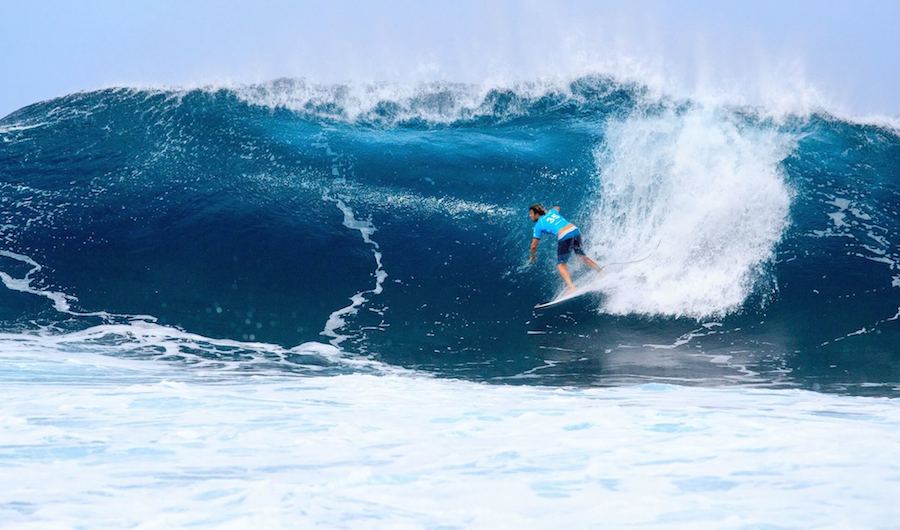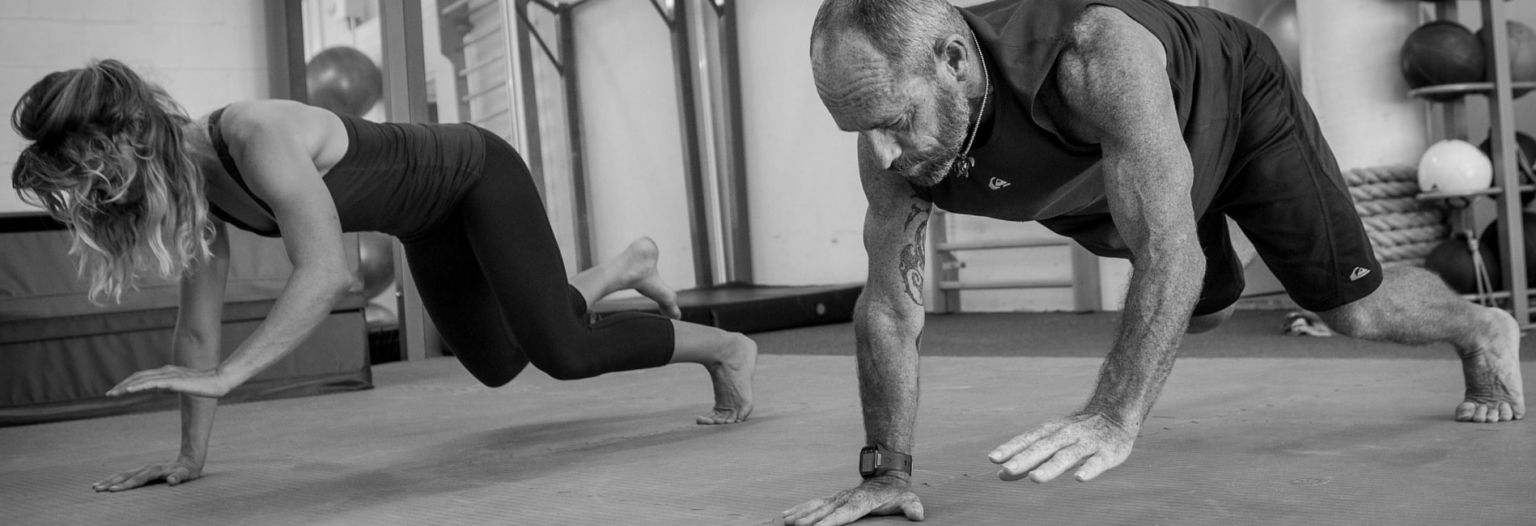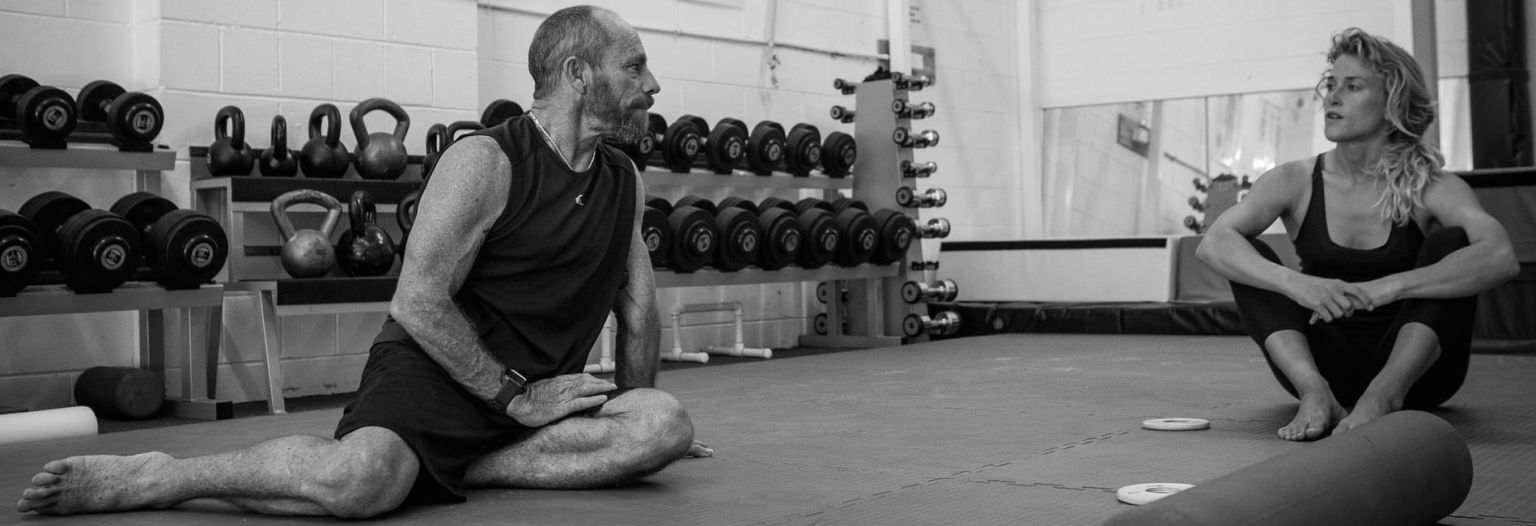
Strength and conditioning programs must be specific to each individual’s body, their chosen sport, their current strengths and weaknesses, their psychological state and the level at which they wish to compete. Strength training is not just about putting on muscle mass and lifting heavy weights, it is about creating co-ordinated, well conditioned muscles that function optimally. Strength training should not be confused with bodybuilding, powerlifting or olympic lifting. Successful surf strength and conditioning programs create light, athletic, mobile, flexible, strong bodies that have the ability to move fluidly and powerfully.
1. Linear Progressions for the Beginner Strength Student
A) Mobility and Stability
First 2-4 weeks. Create a foundation of joint stability and mobility. Often an increase in passive flexibility is an injury waiting to happen. Surfers need mobility (involves multiple joints) as well as flexibility. Mobility refers to the ability to move joints into flexible positions whilst also being stable and strong in these positions.
B) Strength Endurance (12-20 rep)
Start each session with mobility drills and prehabilitation (exercises to prevent injury from occurring in the first place) work where required. For example, some areas often found weak and in need of more strength to prevent injury include: mid and lower trapezius, posterior delts, serratus anterior, deep neck flexors, neck extensors, glutes, hamstrings, shoulder external rotators and trunk rotation to the less dominant side). Upper body strength endurance is paramount in surfers to keep paddle intensity up and get out the back of the set. Train for 2-4 weeks.
*Surfers are contralateral athletes so I would often choose single arm or alternating arm movements such as alternating pulls, pushes and single leg squats. Where possible, I am a big believer in using predominantly bodyweight mobility and strength drills, which can encompass low to max intensities depending on how they are performed.
C) Strength (6-12rep)
Develop thetraditional lifts in addition to other free-weight strength and bodyweight strength work. Examples of traditional lifts include the back squat, front squat, conventional deadlift, sumo deadlift, military press, bench press, pull-up and chin-up. Train uniltateral also, such as Bulgarian split squats, split stance deadlifts, one arm bent-over row, one arm overhead press. Strength and power is required to pop up fast and short bursts of paddle power. Surfers need both hip and knee dominant exercises, both single and double leg exercises, and both stable and unstable surface training. Train for 4 weeks.
D) Max Strength (1-6RM)
Train for two weeks. This will start to stimulate the highest threshold muscle fibres for greater strength gains. If the athlete is very new to this, I would spend a bit more time on this in the higher rep ranges (5RM or 6RM), learning the technique correctly, since it is the foundation to be more powerful and dynamic. Train for 2 weeks.
E) Power
Train for 2 weeks maximum (one to two sessions per week). Perform exercises explosively, such as speed deadlifts, speed box squats, push presses, medicine ball throws/slams, bench throws, plyometric jumps/push-ups/bounds, box jumps, pop-ups, sprints and stair bounds. Strength and power is required for short bursts of paddling, to pop up fast and execute power manoeuvres. For surfing it is also important to train rotary power or anti-rotary power for fast turns and explosive manoeuvres. Again, if the athlete is super new to these lifts, I would hold off the power section and spend a bit more time learning correct lifting technique.
Once the surf athlete has completed at least one full cycle of this linear training from A-E, I would then utilise a Conjugate method of training (rotating lifts and types of training rather than focusing on one aspect of training) for maintenance of the neuromuscular development already achieved and keeping the athlete in a prepared state since surfing events can be anywhere between 0-3 times per month throughout the year. I would not find a linear periodisation system to be useful in such a situation, since time would not allow for the athlete to complete a full linear training cycle which ends in their peaking phase. They would need to maintain strength, strength endurance, power and conditioning throughout the year, and the congugate periodisation system is the only way which I believe would achieve this.

2. Congugate Periodisation Surf Strength & Conditioning
I would use a conjugate system, training concurrently, for athlete maintenance for a variety of reasons. I believe that professional surfers should be prepared at all times, especially when an event could pop up unexpectedly. I believe that the linear periodisation system will actually detrain certain strength aspects as another is being developed and the next phase is entered. For example, moving from a power phase back to a strength endurance phase, will detrain the power gained in the last phase. Also, as Louie Simmons (Westside Barbell) once told me, if you are working on power for 2 weeks and then switch to the next phase, you are missing the benefits you could potentially gain if you had continued to cycle power exercises throughout your program, because there is a lag phase in the body’s ability to adapt to the training stimulus.
The conjugate system for a professional surfer would be comprised of three main training aspects;
A) Mobility Work
This section includes soft tissue work, active stretches, self-mobilisations and full-range strengthening to allow your body to move the way your mind wants it to. This is perhaps the most undervalued aspect of strength and conditioning but is increasingly gaining more attention, particularly for surfers of all ability levels.
B) Strength Endurance Work
Perform lower intensity, higher rep sets (12-30 rep). Exercises are rotated every week by changing either the way the exercise is performed or switching the exercise entirely. Perform in a circuit with little rest. These endurance exercises could be performed as a ‘finisher’ at the end of a strength or speed workout, or as part of conditioning.
C) Heavy Lifting (3-6 RM)
Lifts are rotated each session. Examples of maximal lifts could include conventional deadlifts, sumo deadlifts, split stance deadlifts, box squats, powerlifting squats, hip thrusts, single arm press (triples), weighted pull-ups, etc. Training at near maximal intensities once per month (or less) would stimulate the higher threshold muscle fibres (for power and strength) without leading to unnecessary muscle bulk or restricted range of motion, and would not overload the central nervous system as would training maximal every session. Switching the main lift each session by either changing the way the exercise is performed (bands, decline, grip, chains, etc) or switching the exercise entirely ensures you can train heavy throughout the year by rotating main lifts. 3RM clusters for the squat or deadlift could also be good (3 X 1 rep lifts with 10 sec rest between each lift) which could be less risk of injury.
I would also aim to train complex, bodyweight movements at high intensities rather than relying too much on free weight and barbell training. Surfers need dynamic strength with loads of mobility. Gymnastics sessions could also be considered – flips, arials, landings, etc.
D) Dynamic / Speed / Power
Exercises are rotated every 1-3 weeks. For a pro surfer I would perform dynamic lifting once per week or per fortnight. Choose 1-3 exercises to perform explosively, depending on the complexity and central nervous system demand of the exercise, and follow with accessory and supplementary work to support the main lifts and correct existing muscle imbalances.
A workout example could look like this; speed squats (1-3 rep per set), plyometric jumps off a high box (5 rep per set) and medicine ball slams (6-10 rep per set). The accessory set which follows could include single leg deadfits (8-10rep), cable woodchops/trunk rotation (8-12rep) and shoulder rotator cuff work (15-25rep).
E) Conditioning
Focus on metabolic conditioning and training the energy systems required for improving surfing performance. Surfing fitness requires both aerobic and anaerobic energy systems. For metabolic conditioning for elevating the anaerobic threshold I would include this once per week or once per fortnight depending on what the athlete needs the most. Paddling harder, faster and longer demands the ability of cellular systems to provide energy, using both the aerobic and anaerobic energy systems. The aerobic system is pulled into play for the paddles out the back and the anaerobic system is required for strong, short bursts of power to paddle onto the wave, popping up and for explosive manoeuvres. Examples of this sort of conditioning could include;
- resistance training circuits (eg. 30 second stations with no rest)
- outdoor sprint training land / water
- stair climbs
- breath training land / water
NOTE: In considering program design, the swell conditions will certainly affect training and weekly scheduling of training will be strongly influenced by how good the waves are on a certain day. Therefore, programming will need to allow for flexibility in session times.
In surfing, the athlete obviously needs time in the water, just as an athlete needs skill/tactical training. I would be educating the athlete on the benefits S&C will provide to their surfing, and aim for at least 3 sessions per week with them (2 strength and 1 conditioning/mobility). Each session is influenced by their energy and strength levels on the day.

Tapering for an Event
Tapering usually involves a 40-70% reduction in normal training load. When tapering for a surf event, i would reduce mainly volume rather than intensity because I believe that it is important to keep intensity high for maintaining physical and psychological preparation. For example, if the athlete is used to performing 3-4 sets in pre-competition and then reduces that volume to 1-2 sets in competition season, the body will have reserves for more training yet the intensity will be maintained which is enough to deload the athlete in leading up to a comp.
I would discontinue any heavy strength training one week before the proposed comp date and would not train heavy or intense at all during this time. During this time I would keep up mobility and prehab work, not to mention having bodywork arranged consistently throughout the athlete’s program.